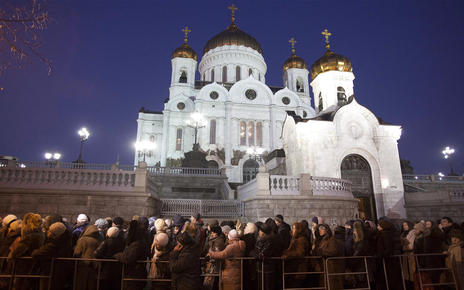 |
| Russian Orthodox believers brave frosty weather to stand in line outside the Christ the Savior Cathedral, in Moscow, in November 2011. Photo: Associated Press. |
Few, however, seem self-reflective enough to examine the results of militant atheism's impact on society in the 20th century. A case in point is Russia.
With the conversion of St. Vladimir, prince of Kiev, in A.D. 988, Christianity became a central part of Russian national identity.
Thereafter, Christianity spread throughout Russia. In fact, after the fall of Constantinople to the Turks in 1453, Russia emerged as the heartland of Eastern Orthodox Christianity, which became central to Russian culture, in art, architecture, music and literature.
All of this dramatically changed with the Russian Revolution in 1917. The original broadly based revolution was swiftly co-opted by Lenin and the Marxists, who promised liberation not only from the feudal tyranny of the czars but from the spiritual bondage of Christianity.
Being officially and militantly atheistic, the Leninist regime set about completely undoing the old religious order of Russia.
Of course, the promised peoples' paradise didn't develop. Quite the contrary. The tyranny of the czars was replaced by the even worse tyranny of Lenin and Stalin.
Beginning in 1917, Leninists and Stalinists set about systematically seizing all church property and destroying church buildings. Militantly atheistic Stalinist totalitarianism would tolerate no competitors to the state for the hearts and minds of the people.
The Russian Orthodox Church was, thus, not merely to be reformed but had to be destroyed. And Stalin's commissars were nothing if not efficient in their suppression of all forms of dissent.
In 1931, the Stalinists obliterated the magnificent Cathedral of Christ the Savior in Moscow, in a barbarous act of wanton destruction.
By 1940 nearly 30,000 churches had been closed, confiscated or destroyed; only 500 remained active in all of the Soviet Union.
Of course this cultural vandalism was nothing compared to the shocking human tragedy as Christians were systematically persecuted, imprisoned and massacred. Russian metropolitans (essentially archbishops) and bishops were regularly murdered and tortured.
One was crucified upside down on the iconostasis of his church. And the lower clergy didn't escape. They were hunted down, tortured, mutilated, buried alive, shot or fed to animals. More than 100,000 priests, monks and nuns were killed; many others were imprisoned in gulags.
Religiously active lay Christians fared little better. Many Christians were sent to psychiatric institutions, since the Soviets considered religious belief a form of mental illness. Others fled into exile. (A sense of the intense evil of these persecutions can be found in the writings of Aleksandr Solzhenitsyn.) The scale of this holocaust against Christians in the Soviet Union compares in some ways to the holocaust against Jews in Nazi Germany.
And this assault was not merely against Christianity. The Soviets attacked the very idea of God, in any form.
Every religious denomination was ruthlessly and bloodily suppressed by the Stalinist commissars, including Judaism, Islam in Central Asia, and Buddhism in Mongolia.
Even more remarkable than the vast scale of devastation, imprisonment, torture and murder of Christians by the Soviets is the fact that these efforts failed.
One would think that, if an ideal atheist state based on pure reason and the rejection of religion could have grown up anywhere, it would have been under Soviet tyranny, which left a people with little formal religious life.
Yet despite four generations of near perpetual persecution and of official atheistic indoctrination in Soviet schools, Christianity survived. By 2008, some 15,000 Russian Orthodox churches had been reopened or built.
The resurrection of Russian Christianity is symbolized by the rebuilding of the magnificent Cathedral of Christ the Savior in Moscow in 2000, 70 years after its demolition.
Other denominations of Christianity are also flourishing today in Russia, including The Church of Jesus Christ of Latter-day Saints, which now claims about 20,000 members.
Thus, a story that began in unthinkable horror concluded with a demonstration of the irrepressible power of faith and of the triumph of the human spirit.
